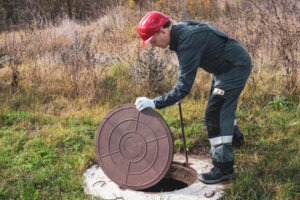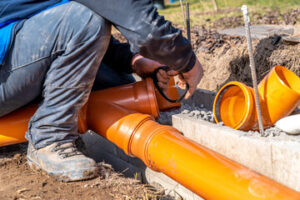Plumbers Bradenton are skilled tradespeople who install, repair and maintain plumbing systems. Their work takes them into homes and businesses to ensure the water supply, toilets, faucets and fixtures function properly.

They use a variety of tools and equipment to complete their tasks, from simple hand tools like wrenches and pipe cutters to more advanced machinery such as leak detection devices and drain snakes. Plumbers also rely on soft skills to communicate effectively and interact with customers.
Over time, your sewer lines are bound to accumulate gunk and grime. Congealed cooking grease, soap scum, decaying food particles, and other waste can build up on the walls of your pipes, causing blockages and leaks that threaten your home or business. Regular sewer line inspections can help prevent these issues by allowing plumbers to monitor the condition of your plumbing infrastructure and address problems before they become major concerns.
A video inspection camera is an essential piece of equipment for monitoring the integrity of your sewer pipes. It consists of a flexible rod with a high-definition video camera mounted on it that can be fed through the sewer pipe. As the camera moves, it transmits live footage to a monitor in real time, allowing plumbers to observe and assess the condition of your pipes. This helps identify and locate any damage or blockages, allowing them to develop the best repair plan quickly and efficiently.
When a plumber is conducting a video sewer inspection, they will first flush running water through the pipes to ensure that there are no obstructions blocking the view. This will also help lubricate the camera and reduce the risk of it catching on any debris in the pipes. Next, they will insert the camera into a cleanout and begin exploring. Before deploying the camera, it’s important to make sure that it has a sufficient battery life and is properly calibrated for the specific conditions of the pipe.
As the camera travels through the pipes, it should be able to identify any existing problems such as offset joints, clogs, and other defects. Depending on the severity of the issue, the plumber may then be able to recommend more invasive repair methods.
A video inspection can also be used to determine if tree roots are invading the sewer line. Since trees and shrubs are naturally attracted to the moisture in drain and sewer lines, they can easily grow into them and cause serious leaks or clogs. A video inspection can help homeowners and property owners avoid costly repairs by identifying these intrusions early on. It can also give potential buyers peace of mind when they’re buying a new home, ensuring that there are no hidden problems with the plumbing that would require expensive repairs later on.
Pulling Units and Hydraulic Pumps
Hydraulic pump systems provide the power necessary to insert and seat pipe liners. This allows for the use of trenchless repair methods that reduce disruption to ground surfaces and preserve landscaping, driveways, and other surface structures. In addition, these systems are capable of generating higher levels of power and force than pneumatic pumps, making them ideal for heavy-duty applications.
In order to monitor hydraulic system performance, plumbers should use a number of tools, including visual and sound inspections, amperage draw tests, and temperature assessments. For example, if a hydraulic motor fails to build adequate pressure during operation, it may be due to a flow limitation or an electrical problem. Performing an isolation test can help plumbers determine whether the issue lies with the pump, relief valve, or somewhere downstream in the system. This can be accomplished by closing a valve, plugging a line, or blocking the pump relief valve.
Air hydraulic pumps use compressed air to generate hydraulic power and motion. These energy-efficient systems are ideal for use in a variety of applications, from automotive clutch systems to industrial production equipment. They are also more reliable and flexible than traditional piston-and-rod hydraulic systems, offering high levels of torque without requiring constant airflow to maintain pressure.
Hydraulic hoses or tubes serve as the conduits for transporting hydraulic fluid throughout a system. They must be robust and leak-resistant in order to protect the system from damage, ensuring continuous and reliable function.
The hydraulic pump unit (HPU) draws hydraulic fluid from a reservoir through the intake valve, then pressurizes and directs it to the hydraulic cylinders or actuators via the discharge valve and hoses. HPUs are available in single- and double-acting models, with the former providing pressing power only as hydraulic fluid enters and moves a piston in one direction while the latter provides both pushing and pulling power.
To monitor hydraulic system performance, it is important to check for contamination. A routine inspection can reveal issues, such as a shop rag wrapped around the breather cap opening or a filter that is blocked by debris. In addition, plumbers should conduct amperage and temperature checks on the electric motor to ensure they are operating within their rating.
Augers and Power Snakes
A trusty drain snake, or auger, is a plumber’s best friend in the battle against pesky and stubborn clogs. These long, flexible cable tools allow plumbers to mechanically power through even the most obstinate drain blockages by feeding the coiled snake head down the pipe and hooking it onto the obstruction. This enables plumbers to retrieve and remove hair clumps, congealed grease and gunk, stuck objects, and more.
A typical plumbing snake consists of a long, flexible metal cable and a coiled snake head attached to the end, with a crank handle on the drum that allows you to feed it into the drain. The drum contains a core that creates a spiraling effect, enabling the snake to latch on to and bore into obstructions.
Depending on the job at hand, you’ll need to select the appropriate length of pipe for your snake. For example, a longer drum auger snake will be required to tackle toilet clogs, as opposed to a shorter sink or shower snake. Then, once the drum is fed into the drain, rotate the handle slowly and carefully to avoid causing a clog or damaging the piping.
As you rotate the handle, watch for the snake head to latch onto the clog and begin breaking it up or pulling it out. If you encounter excessive resistance, don’t force the cable. This can kink the cable or cause it to break, and may also damage your pipes with overly powerful torque. Instead, keep rotating the handle and adjusting the snake angle as needed to navigate around pipe curves and corners. If the clog doesn’t dislodge after several attempts, it’s likely time to call in the big guns. An electric or sectional cable machine is a powerful and effective choice for tackling major clogs and deep obstructions that a simple drain snake cannot. They’re available in a range of sizes, with larger models capable of reaching deeper into your home’s sewer pipes. They’re more expensive than home-grade plumbing snakes, but are a reliable tool for ongoing sewer maintenance and troubleshooting. They can be used to monitor the condition of your plumbing pipes, and alert you to future clogs or other problems.
Sewer Cleaners
A household’s plumbing pipes run into a larger, municipal sewer system where wastewater is processed before it is released back into the environment. These pipes often become clogged with solid waste, leading to slow drains and sewage backups. Professional sewer cleaners use powerful, high-pressure water jets to remove debris and restore proper flow. They also inspect pipes using video cameras to identify problems and develop the best cleaning approach.
Many municipalities manage their own sewer maintenance programs, but private property owners can also contract with them for service. Regardless of who is responsible for a given pipe, regularly scheduled cleanings help minimize costly repairs and improve efficiency.
Before beginning any work, plumbers set up a safe working area with safety cones and ensure that hazard flasher lights are functioning properly. They then drive a truck equipped with a vacuum tank and a power-washing nozzle to the site of the blocked pipe. Once on-site, they begin by opening a manhole or other access point, and then they insert the nozzle at the closest cleanout to the blockage.
When the nozzle is positioned at the correct angle, the plumber releases water to break up and wash away obstructions. If the clog is particularly stubborn, they may use a motorized drain auger to cut and pull out large blocks of debris. For more effective cleaning, they may follow up with a hydraulic cleaning process.
Some companies use biological products that contain microorganisms that digest fats, oils and other waste. These solutions are safer than conventional chemicals, but they must be applied correctly to be effective. Most plumbers use them in high-grease areas near restaurants and while spot cleaning specific clogs.
It’s important for sewer cleaners to keep accurate records of their inspections and cleanings. Strong record-keeping helps them develop efficient maintenance plans and identify problem sections of pipe that need more attention. In addition, it enables them to provide proof to homeowners that their services have been performed. This helps homeowners avoid costly plumbing bills and potential health hazards associated with clogged, untreated pipes. A regular sewer cleaning can also help reduce the risk of environmental pollution due to sewage spills or water contamination.
